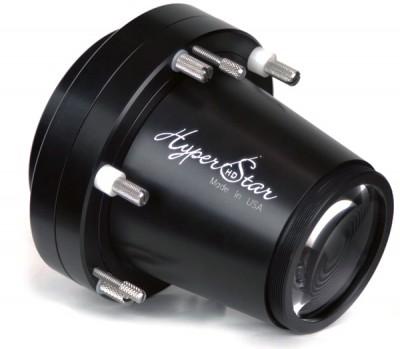
What is HyperStar?
HyperStar is the easiest way to capture deep-sky astrophotos. The patented HyperStar unit is a multiple-lens corrector which replaces the secondary mirror on a Schmidt-Cassegrain telescope and allows extremely fast CCD imaging. Depending on the size of the telescope, the resulting focal ratio will be between f/1.9 and f/2.3, up to 28 times faster than imaging at f/10! Removing the secondary mirror and installing the HyperStar lens is very quick and easy. No tools are required and switching between the HyperStar and regular f/10 modes of the telescope takes only a couple minutes. HyperStar provides the easiest and fastest means of imaging deep-sky celestial objects!
Click here for a French translation by Thierry Martin


Above: Optical diagram of how the HyperStar lens works. Left picture shows standard SCT arrangement. Right picture shows secondary mirror removed and HyperStar lens installed. (Optical diagram of the HyperStar lens is illustrative only.)

Above: A CCD camera mounted to the HyperStar lens on an 8" Schmidt-Cassegrain telescope
The secondary mirror is removed from the telescope and placed into a holder (included with the HyperStar lens) which keeps the mirror safe. Replacing the mirror with the HyperStar lens is a very easy process that takes only seconds to do. The secondary mirror is indexed so that when it is replaced in the telescope, collimation is retained and no adjustments are necessary.
What are the Advantages of HyperStar?
The primary advantage of HyperStar is speed. The table below compares exposure times at various focal ratios. Exposures that take the better part of an hour at f/10 take mere seconds with the HyperStar lens!
| Focal Ratio | Equal Exposure Times | Equal Exposure Times |
| f/10 | 12.5 minutes | 25 minutes |
| f/6.3 | 5.0 minutes | 10 minutes |
| f/5 | 3.1 minutes | 6.3 minutes |
| f/3.3 | 1.4 minutes | 2.7 minutes |
| f/2 | 30 seconds | 60 seconds |
Aside from the obvious savings in time and effort, short exposure times have an additional advantage: capturing images is much easier. With typical exposure times of 20-60 seconds, HyperStar imaging allows unguided imaging. Long exposures require a telescope to be guided due to inherent tracking errors in the drive. This requires a second CCD camera or self-guiding CCD and often other hardware such as a guidescope. HyperStar images can be shot unguided thanks to the extremely short exposure.
An additional benefit of short exposures is that it is often possible to image with a telescope in alt-azimuth mode. This means it is possible to capture deep-sky images with a fork-mounted SCT without needing an equatorial wedge. This saves the trouble of mounting the scope on a wedge plus having to polar align the telescope. CCD imaging simply doesn't get any easier than that!
Image Comparison
The image below compares an image taken with the same camera on two different optical systems. The left image was taken using a 100mm f/5 apochromatic 5-element flat-field refractor, an excellent and popular design for deep-sky imaging. The total exposure time was one hour. On the right is the same object imaged with a HyperStar lens on a 14" Celestron SCT. The total exposure time is just 90 seconds! The amount of detail captured is at least as good as, if not better than, the refractor. The stars appear smaller and sharper in the HyperStar image with no hint of the blue fringing that appears around bright stars even in very good refractors. Plus the HyperStar image was done 40 times faster!

Which Cameras are Compatible with HyperStar?
The compatible cameras depend primarily on the size of the telescope. The main limiting factors are the physical size of the camera body and the size of the CCD chip that can be illuminated. Larger CCD cameras may not be compatible with smaller telescopes due to the large central obstruction they would create. Most new CCDs are quite compact, so this is rarely an issue. The other limit is based on the size of the CCD chip. A HyperStar lens can only illuminate a certain size CCD chip due to the size of the telescope and size of the opening in the corrector plate for the HyperStar lens itself.
Cameras Compatible with 6" HyperStar Lens
- Astrovid Stellacam
- Atik 4-Series
- Mallincam
- Starlight Xpress (11mm or smaller sensors)
Cameras Compatible with 8" and Larger HyperStar Lenses
- Astrovid StellaCam
- Atik 3-Series
- Atik 4-Series
- Celestron Nightscape
- Mallincam
- Meade DSI & DSI Pro
- Orion StarShoot (I, II, and G3)
- Starlight Xpress (all models except H35/36)
Additional Cameras Compatible with 9.25" and Larger HyperStar Lenses
- All of the above cameras, plus:
- Canon EOS DSLRs*
- Nikon DSLRs*
- QSI 500 & 600 Series
- SBIG ST-8300
- SBIG ST-7/8/9/10/2000/4000
Additional Cameras Compatible with 14" HyperStar Lenses
- All of the above cameras, plus:
- Atik 4000/11000*
- Orion StarShoot Pro
* HyperStar lenses are designed for APS-format (27mm diagonal) sensors. Sensors larger than APS-format will show significant vignetting in the corners of the image due to the restrictions on the HyperStar lens imposed by the size of the opening in the telescope corrector plate. Flat-field images are recommended for minimizing the effects of vignetting on larger sensors.

